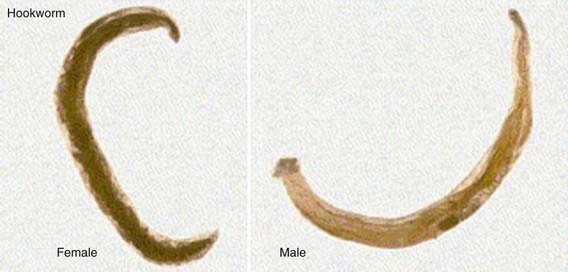Chapter 284 Hookworms (Necator americanus and Ancylostoma spp.)
Etiology
The infective larval stages of the anthropophilic hookworms live in a developmentally arrested state in warm, moist soil. Larvae infect humans either by penetrating through the skin (N. americanus and A. duodenale) or when they are ingested (A. duodenale). Larvae entering the human host by skin penetration undergo extraintestinal migration through the venous circulation and lungs before they are swallowed, whereas orally ingested larvae may undergo extraintestinal migration or remain in the gastrointestinal tract. Larvae returning to the small intestine undergo 2 molts to become adult sexually mature male and female worms ranging in length from 5 to 13 mm. The buccal capsule of the adult hookworm is armed with cutting plates (N. americanus) or teeth (A. duodenale) to facilitate attachment to the mucosa and submucosa of the small intestine. Hookworms can remain in the intestine for 1-5 yr, where they mate and produce eggs. Although approximately 2 mo is required for the larval stages of hookworms to undergo extraintestinal migration and develop into mature adults, A. duodenale larvae may remain developmentally arrested for many months before resuming development in the intestine. Mature A. duodenale female worms produce about 30,000 eggs/day; daily egg production by N. americanus is <10,000/day (Fig. 284-1). The eggs are thin shelled and ovoid, measuring approximately 40-60 µm. Eggs that are deposited on soil with adequate moisture and shade develop into 1st stage larvae and hatch. Over the ensuing several days and under appropriate conditions, the larvae molt twice to the infective stage. Infective larvae are developmentally arrested and nonfeeding. They migrate vertically in the soil until they either infect a new host or exhaust their lipid metabolic reserves and die.




